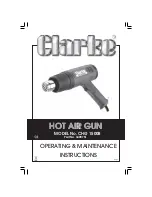
INSTRUCTIONS FOR USE.
With the ON/OFF switch in its central - OFF position, plug the tool into the mains.
Before starting work on a particular workpiece, it is recommended that, where
necessary, you heat a test piece to ensure you have the correct heat setting. In
addition, you should take steps to protect sensitive or delicate areas where the
effect of heat could cause damage. Always plan ahead - preparation is the key.
When all preparations have been completed, switch the tool ON to positions I or
II, as required, ensuring it is facing away from you. Bring the tool to the workpiece
and maintain a distance of approx. 3cm from the surface.
Paint will rapidly become soft and blister, when it can then be scraped off. Do not
allow the paint to burn as this will make the scraping process more difficult.
Heating and scraping is performed simultaneously, with the scraper just following
the gun. Clean the scraper blade quickly if paint should stick to it.
Profiled parts may be brushed with a suitable wire brush once the paint is softened.
Only one pass is normally required to scrape off paint layers - thick or thin.
Do not point the gun directly at glass, ensure it is adequately protected. A
protection nozzle is supplied for use when stripping window frames etc., and is
used as follows:
Slide the protection nozzle over the nozzle of the gun, ensuring it is in the right
6
Air Flo
w
Glass pane
Protection Nozzle
plane so that the gun can be placed
comfortably against a window, with the cowl
of the protection nozzle backed on to the
glass as shown in the diagram.
It will be necessary to change the position
of the protection nozzle on the gun as you
work around the window pane - ensure you
wear adequate glove protection when you
do so.
The protection nozzle must be kept in
contact with the work, but do not spend too
long in any one area.
Forming and Welding Plastic Parts
For bending or forming plastic or polyethylene parts, work slowly and with great
care, obs.erving the effects of heat on such materials.
WARNING! With plastics, the temperature range between solid, pliable and
liquid states is narrow.
Ungluing and Dissolving Glues
Most adhesives dissolve when heated. Assembled parts may then be disassembled
and excessive glue melted away. Take care however, to ensure that the parts
from which glue is taken is heat resistant.

























